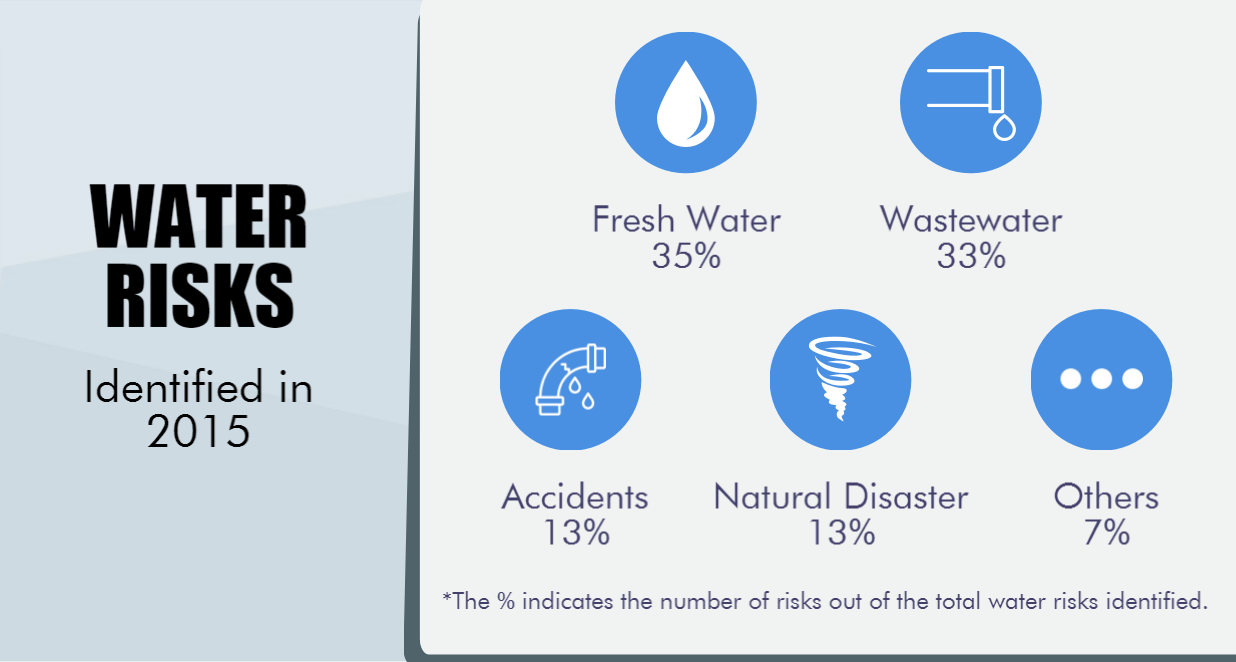Mitigating water risks is one of the
key long-term goals of Dell's 2020 "Legacy of Good" Plan. Since 2015, Dell has devoted
efforts to promoting supply chain water risk control, and plans to encourage
250 to 300 water-intensive suppliers to join its water risk mitigation project
by 2020. By adopting a water risk mitigation plan, Dell ensures that supply
chain water risks are effectively managed.
Since the launch of the project in
2015, more than 100 water-intensive suppliers have comprehensively identified
and assessed water risks linked to production processes, and taken subsequent measures
to control identified risks.
Among those participating suppliers,
50 suppliers that took part in Dell's water risk mitigation program in 2015
identified a total of 167 water risks. These risks include:
- Freshwater usage risks: Significant
water consumption during manufacturing, pollution of water sources, water wasted
during usage, etc.
- Wastewater discharge risks: Risk
of excessive wastewater discharge
- Water contamination accident
risks: Wastewater treatment system failure or damage to pipelines; outbreak of
fires; chemical leakages
- Natural disaster risks: Pollution
due to flooding, typhoons, drought, etc.
- Other water risks

To tackle the above risks, suppliers
proposed a total of 153 plans for water risk control. They adopted mitigation measures
such as recycling reclaimed water; collection, purification and recovery of
rainwater; refining water-saving equipment; analysis of water consumption
measurements; increasing the frequency of wastewater tests; checking for
pipeline leakages; and preparation and practicing of emergency action plans.
By 2016, a total of 1,029,821 tons of
water had been saved, whilst wastewater had been reduced by 3,074,267 tons.
Figure 1. Freshwater Consumption of Selected Dell
Suppliers
Figure 2 – Wastewater
Discharge of Selected Dell Suppliers
Several water-saving measures
implemented over the course of the project pose value and implications worth
studying:
Qunguang Photoelectric
Co., Ltd. (Suzhou) installed energy-saving faucets in its staff dormitory area.
It also replaced low-capacity flushing tanks on toilets with high-capacity
tanks, as well as canteen and bathroom faucets with delayed spray faucets. Implemented
measures resulted in a total of 33,288 tons of water saved in 2016.
After a water
risk identification assessment, Zhongda Electronics Co., Ltd. (Jiangsu) began collecting
water from their air conditioning and steam supply systems into a tank on the
rooftop of the building to be used for toilet flushing, condensation and other areas.
The tank installation reduced the amount of water in circulation in the
air-conditioning system as well as the amount of water used for domestic
purposes. These measures helped the enterprise save 8,575 tons of water in
2016.
In
addition, the factory is implementing a system for rainwater collection and reuse.
After filtering and purification, the collected water will be used for cleaning
sanitary ware, saving another 5,000 tons of water per year.
As part of the assessment for
supplier performance, Dell also requires all water-intensive suppliers
participating in the water risk mitigation project to fill in and publish their
pollutant release and transfer data via IPE's website. This disclosure includes
information on water consumption and pollutants in effluent.
Dell will continue actuating its
supply chain water risk mitigation plan to identify and assess water risks, and
continue to follow up on the effective implementation of water risk mitigation
plans in order to ensure that Dell's supply chain water risks are effectively
managed, thus fulfilling the brand's corporate social and environmental
responsibility.
(The above content was provided to IPE by the brand, who is responsible for the accuracy of the data.)